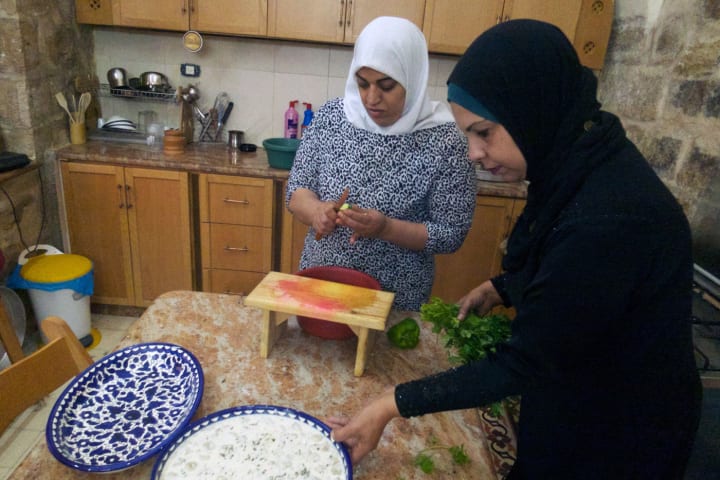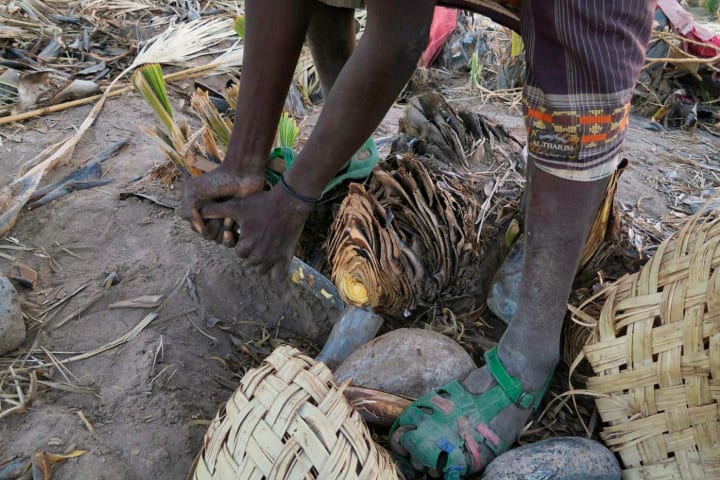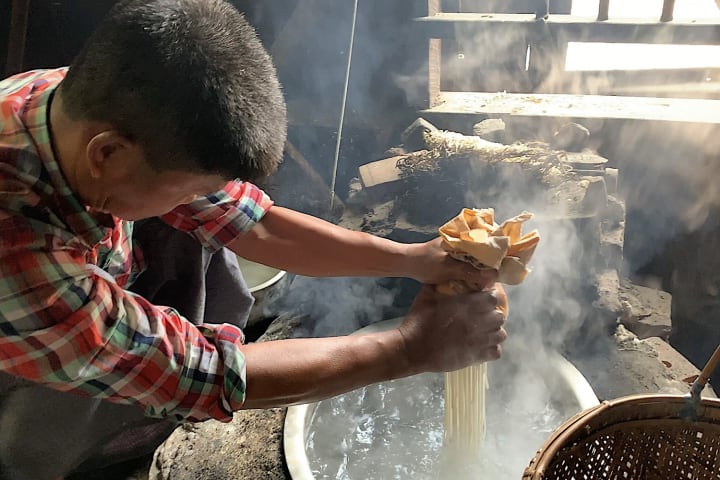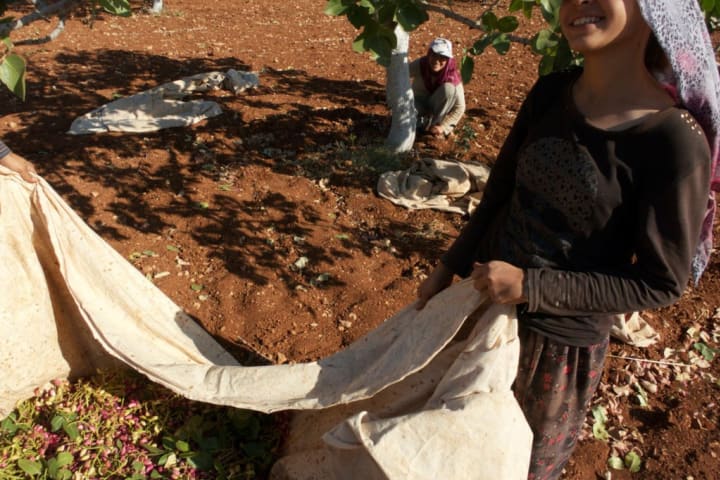IDEA SET
IDEA SET
Exploring Food Traditions with the Out of Eden Walk
Exploring Food Traditions with the Out of Eden Walk
Explore diverse stories of food traditions with National Geographic Explorer and journalist Paul Salopek. Analyze stories of food traditions from around the world and challenge students to identify stories from their own communities.
Grades
5 - 12
Subjects
Social Studies, English Language Arts, Storytelling, Anthropology, Geography

Paul Salopek
National Geographic Explorer Paul Salopek is walking 24,000 miles across the planet, following the path of early human migration from East Africa to South America and capturing local stories as he travels. This slow journey across the Earth, which he calls the Out of Eden Walk, gives him a human perspective on the major stories of our time. You can introduce students to Paul’s walk with this short video and access all of the stories from Paul and his walking partners here.
This idea set provides tools to examine stories about food from the Out of Eden Walk with students. The stories show the various roles that growing, buying, cooking, and eating food can play in communities across the world.
This idea set is part of a collection called Out of Eden 10th Anniversary: Food.

Building Background Knowledge: Food
Before exploring dispatches from the Out of Eden Walk, take some time to activate prior knowledge and build background knowledge on food's role in society, including where it comes from, how it is prepared, how it is valued, and how it is shared within communities and families. Introduce your students to key ideas about food with a quick-write on the questions:
- What roles does food play in our lives, other than just keeping us alive? Why is food important and meaningful to a family or community?
- If students do not identify strongly with the questions above, consider a more focused follow up:
- How does food help us to maintain our cultural identity or strengthen our bonds with our family and community?
- Ask students to pair-share, comparing their answers and finding similarities and differences.
Use the Key Concepts tool to have students define and provide examples of important ideas and terms that they will encounter as they discuss the Out of Eden Walk materials. Terms could include:
- Cuisine
- Culture
- Tradition
- Staple Food
- Feast
- Fasting
- Ritual
- Dietary Laws

Stories of Food Traditions from the Out of Eden Walk
Paul Salopek, his walking partners, and other collaborators have collected stories from many cultures along the Out of Eden Walk. The following stories highlight practices and rituals surrounding food in various regions. They explore culture through a food lens, describing how food is acquired, prepared, and consumed and how it connects people from around the world.
The articles, regular dispatches written by Paul throughout the journey, are available at several reading levels. There are also multimedia resources from the walk: “milestones” are snapshots Paul records every 100 miles on the trek. These contain videos, panoramic photographs, and brief interviews with the first person he encounters at each location. Walking tours include interactive maps with photos and narration that guide readers through key locations along the route. Consider assigning different articles to groups of students in your class for analysis and discussion. Students can also locate the regions Paul and his walking partners visit using National Geographic Mapmaker. Other cooperative learning activities such as stations and jigsaw would also work well for exploring these resources (more specific activities and tools are included in the next section).
- Gona: First Kitchen: (article) Paul visits Gona, a site in Ethiopia that is 2.6 million years old and contains numerous stone artifacts used to prepare food. He interviews a Harvard professor who discusses the benefits humans received from using controlled fire to cook meat.
- Trail Notes: The Prince: (article) A member of the royal family of Saudi Arabia joins Paul for lunch at a remote stop along the walk. Paul and his walking partners discuss how to host a prince with the food and supplies they have brought on their walk.
- The Prophet’s Mosque: (article) Thousands of Muslims share a meal at a famed mosque in Saudi Arabia to break their fast during Ramadan, the holiest month of the Muslim lunar calendar.
- Aftertaste: (article) Groups of Palestinian women cook traditional meals together at a cooperative in the West Bank. They teach cooking classes and are writing a cookbook to help preserve their cultural history. Paul and his guide join the women to prepare a meal and learn about their mission.
- Pistachio Mafia: (article) Pistachios are a staple food and a source of great pride in Turkey. Paul meets pistachio farmers and guards protecting the orchards.
- What Powers a Walk Across the World? A Bowl of Mont Di, To Start: (article) Mont di is a national noodle dish still made by hand in villages in Myanmar. Paul observes a local cook as she teaches others the challenging multi step process of making the beloved rice noodles.

Exploring Food Traditions with the Out of Eden Walk
As your students explore the Out of Eden Walk, use the Learning Tools below to look more closely at what these stories can reveal about the cultural significance of food.
- Use the See, Think, Wonder Learning Tool with the video from the “What Powers a Walk Across the World?” article or a striking image from one of the other articles. You may want to assign different images to different student groups, then have groups share. Collect student questions and categorize them to identify topics for more exploration.
- Break students into small groups, assigning each group an article or dispatch to read and discuss. Have students use the Save the Last Word for Me discussion protocol to examine the text closely. As they read, ask them to choose their passage based on what it shows about food patterns and traditions in the region or culture.
- Conduct a structured group discussion with your students to analyze the links between stories. Use the Socratic Seminar format from the Conducting Powerful Conversations Learning Tool to help students think critically about and make connections between the varied stories of food from the Out of Eden Walk and other resources you may be using in your classroom. Use the guiding questions below to begin the discussion. Encourage students to speak to each other and use examples from their texts:
- What was the most surprising thing you learned from these stories? Why did that surprise you?
- What are some of the similarities between the stories about food preparation and traditions we have seen? What are some of the differences?
- How have the stories about food in the Out of Eden Walk reminded you of food traditions and practices in your own community? Explain.
You may want to “fishbowl” your classroom discussions to allow smaller groups to discuss while the larger group observes. See the Learning Tool for more details on this practice.

Extensions: Exploring Food Traditions in Your Community
Let your students become Explorers! Connect the stories of food from the Out of Eden Walk to stories of food in your own community.
- Work together as a class to develop a set of interview questions that you would want to know about the history and importance of food in various cultures. Consider the questions that arose in earlier activities. Then, use the Oral Storytelling: InterviewsTipsheet to help students interview people in their lives who are passionate about food (e.g., a grandparent or other family member who helps maintain family food traditions, a local shopkeeper or restaurant owner, etc.) and have them describe the role and importance of food in their community, their culture, and for them individually.
- Create a walking tour of your community with stops that highlight the diversity of food traditions and practices in your area. Include as wide a representation of food locations as possible; homes where they have eaten, specialty shops, delis, grocery stores, food trucks, bakeries, and restaurants. Each map will vary depending on what is present in your area. Use National Geographic Mapmaker to print a map of your community and chart a walk with different stops.
Read stories from the Out of Eden Walk HomeStories project and select three to four stories that highlight food and food practices and traditions to explore more deeply. Encourage students to choose from a variety of regions using the HomeStories map. They can use thinking maps to compare and contrast the food stories shared in various entries, identifying similarities and differences among the responses. In small groups, students can share their reflections on the HomeStories they selected. Students can also create their own HomeStories as a possible home extension (requires an original photo).
Media Credits
The audio, illustrations, photos, and videos are credited beneath the media asset, except for promotional images, which generally link to another page that contains the media credit. The Rights Holder for media is the person or group credited.
Last Updated
March 8, 2024
For information on user permissions, please read our Terms of Service. If you have questions about how to cite anything on our website in your project or classroom presentation, please contact your teacher. They will best know the preferred format. When you reach out to them, you will need the page title, URL, and the date you accessed the resource.
Media
If a media asset is downloadable, a download button appears in the corner of the media viewer. If no button appears, you cannot download or save the media.
Text
Text on this page is printable and can be used according to our Terms of Service.
Interactives
Any interactives on this page can only be played while you are visiting our website. You cannot download interactives.